HI5019: Strategic Information System Analysis for Rainbow Illusion
VerifiedAdded on 2022/11/23
|13
|3095
|357
Report
AI Summary
This report provides an in-depth analysis of the strategic information system employed by Rainbow Illusion, a New Zealand retail chain. It begins with an executive summary and an introduction, outlining the company's current sales transaction system, which combines manual and centralized data processing. The report identifies six major strengths of the existing system, including enhanced accuracy, efficient decision-making capabilities, and the ability to handle errors at the store level. It also highlights the system's ability to avoid data manipulation and reduce business cycle times. The report then explores situational pressures that could enhance the chances of fraud within the system, such as human error and data manipulation. The core of the report compares the centralized system with a distributed system, emphasizing the benefits of the latter. Finally, the report offers recommendations for Rainbow Illusion to improve its sales transaction system, concluding with a summary of the findings and a list of references.
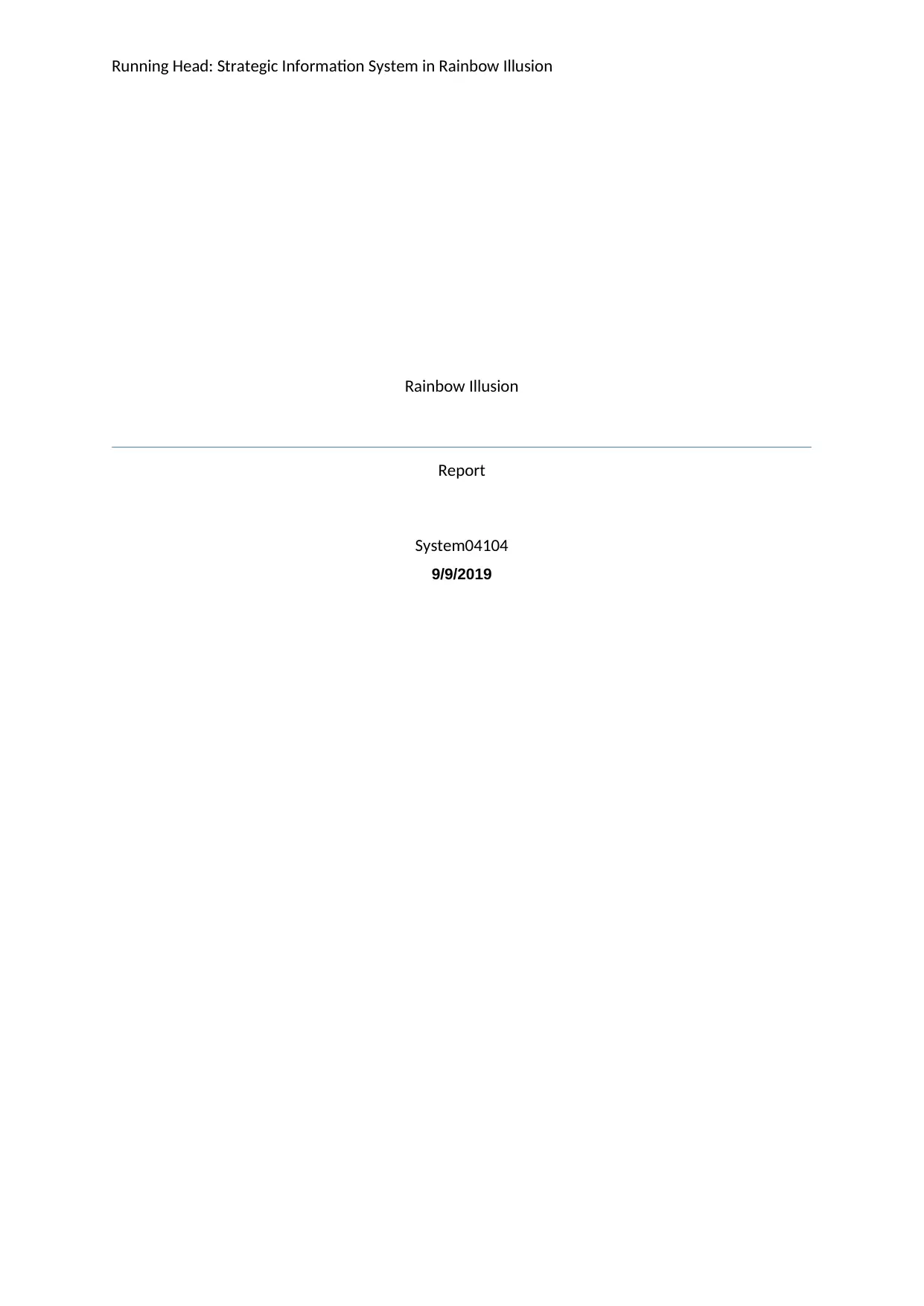
Running Head: Strategic Information System in Rainbow Illusion
Rainbow Illusion
Report
System04104
9/9/2019
Rainbow Illusion
Report
System04104
9/9/2019
Paraphrase This Document
Need a fresh take? Get an instant paraphrase of this document with our AI Paraphraser
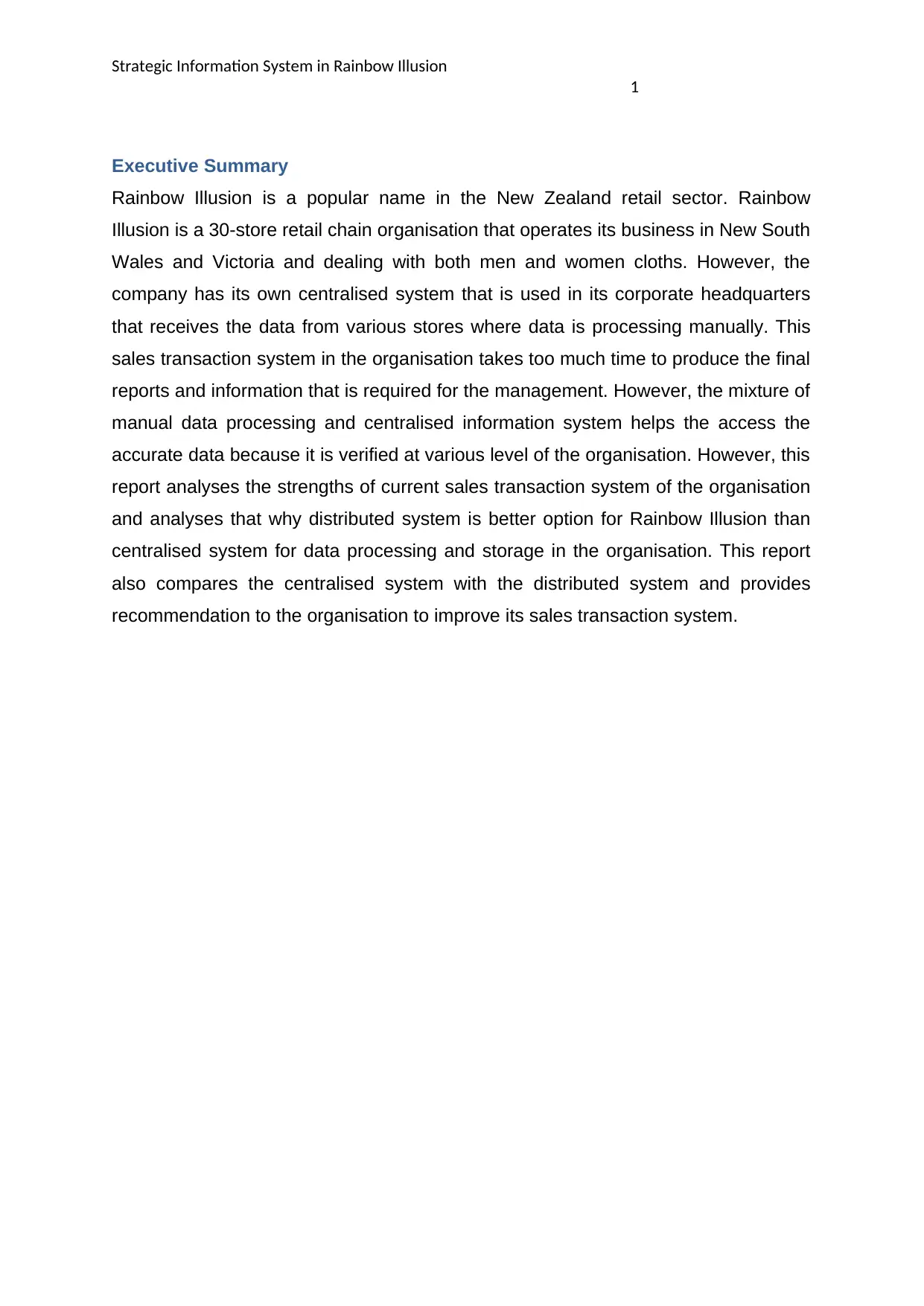
Strategic Information System in Rainbow Illusion
1
Executive Summary
Rainbow Illusion is a popular name in the New Zealand retail sector. Rainbow
Illusion is a 30-store retail chain organisation that operates its business in New South
Wales and Victoria and dealing with both men and women cloths. However, the
company has its own centralised system that is used in its corporate headquarters
that receives the data from various stores where data is processing manually. This
sales transaction system in the organisation takes too much time to produce the final
reports and information that is required for the management. However, the mixture of
manual data processing and centralised information system helps the access the
accurate data because it is verified at various level of the organisation. However, this
report analyses the strengths of current sales transaction system of the organisation
and analyses that why distributed system is better option for Rainbow Illusion than
centralised system for data processing and storage in the organisation. This report
also compares the centralised system with the distributed system and provides
recommendation to the organisation to improve its sales transaction system.
1
Executive Summary
Rainbow Illusion is a popular name in the New Zealand retail sector. Rainbow
Illusion is a 30-store retail chain organisation that operates its business in New South
Wales and Victoria and dealing with both men and women cloths. However, the
company has its own centralised system that is used in its corporate headquarters
that receives the data from various stores where data is processing manually. This
sales transaction system in the organisation takes too much time to produce the final
reports and information that is required for the management. However, the mixture of
manual data processing and centralised information system helps the access the
accurate data because it is verified at various level of the organisation. However, this
report analyses the strengths of current sales transaction system of the organisation
and analyses that why distributed system is better option for Rainbow Illusion than
centralised system for data processing and storage in the organisation. This report
also compares the centralised system with the distributed system and provides
recommendation to the organisation to improve its sales transaction system.
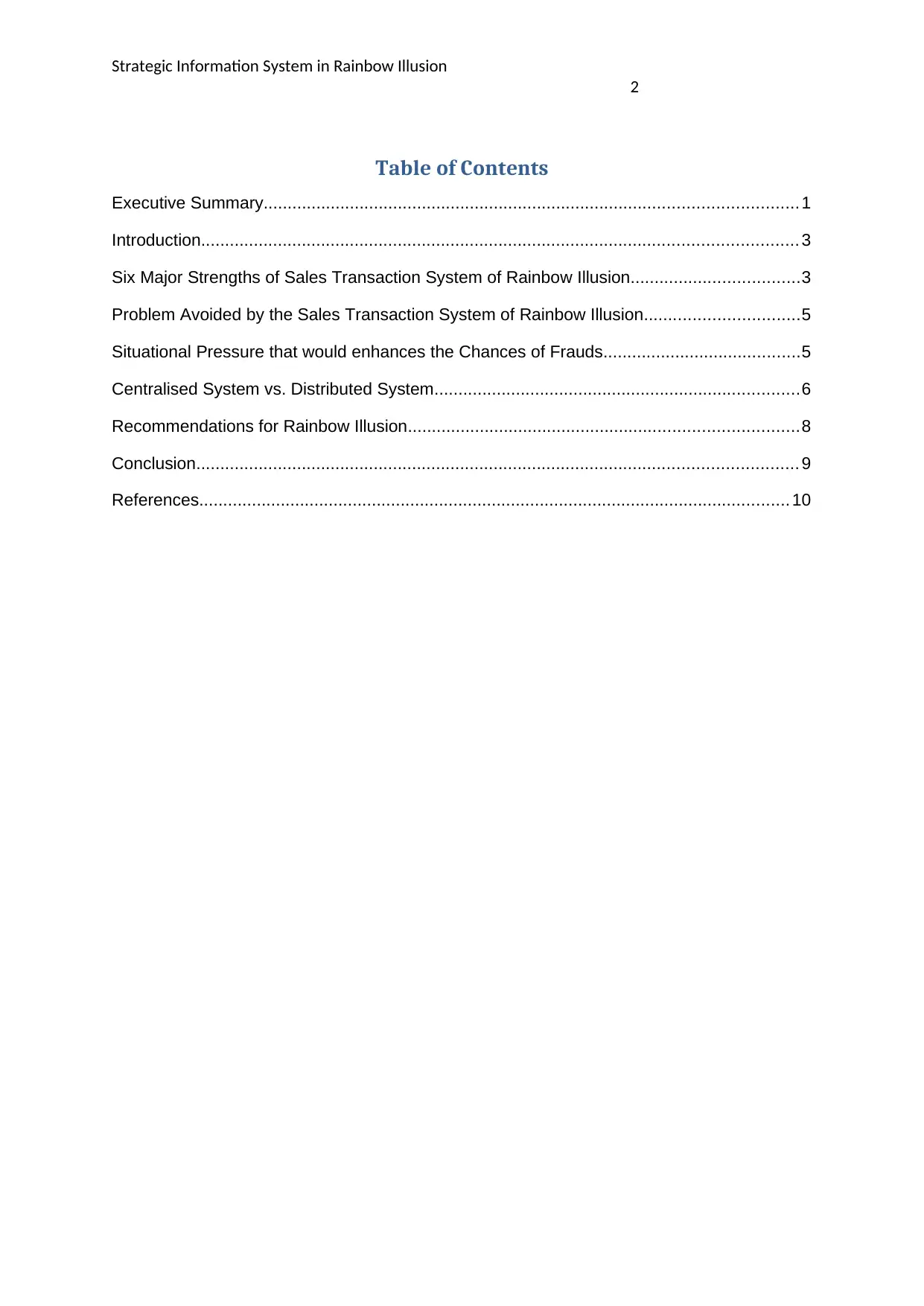
Strategic Information System in Rainbow Illusion
2
Table of Contents
Executive Summary............................................................................................................... 1
Introduction............................................................................................................................ 3
Six Major Strengths of Sales Transaction System of Rainbow Illusion...................................3
Problem Avoided by the Sales Transaction System of Rainbow Illusion................................5
Situational Pressure that would enhances the Chances of Frauds.........................................5
Centralised System vs. Distributed System............................................................................6
Recommendations for Rainbow Illusion.................................................................................8
Conclusion............................................................................................................................. 9
References........................................................................................................................... 10
2
Table of Contents
Executive Summary............................................................................................................... 1
Introduction............................................................................................................................ 3
Six Major Strengths of Sales Transaction System of Rainbow Illusion...................................3
Problem Avoided by the Sales Transaction System of Rainbow Illusion................................5
Situational Pressure that would enhances the Chances of Frauds.........................................5
Centralised System vs. Distributed System............................................................................6
Recommendations for Rainbow Illusion.................................................................................8
Conclusion............................................................................................................................. 9
References........................................................................................................................... 10
⊘ This is a preview!⊘
Do you want full access?
Subscribe today to unlock all pages.

Trusted by 1+ million students worldwide
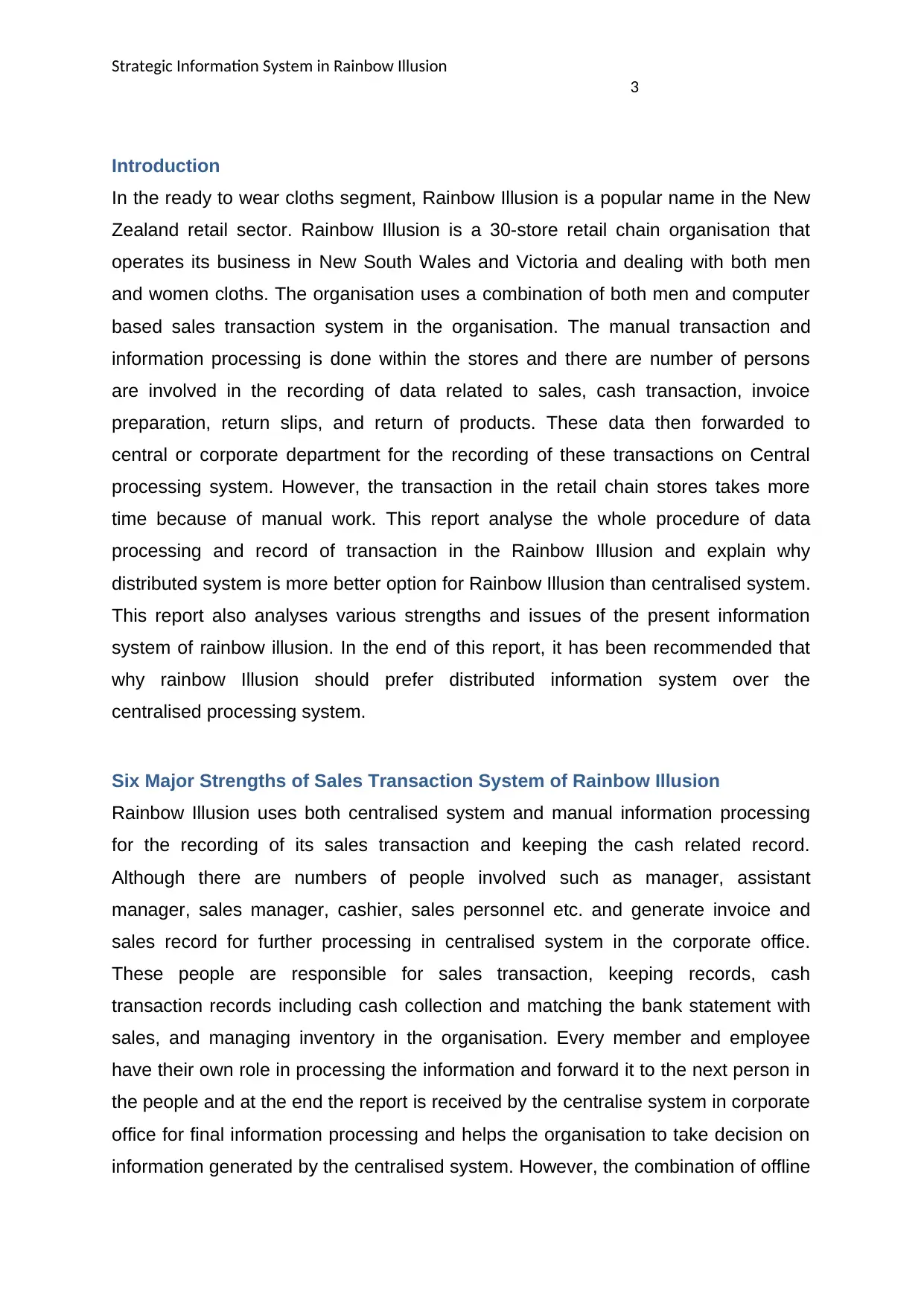
Strategic Information System in Rainbow Illusion
3
Introduction
In the ready to wear cloths segment, Rainbow Illusion is a popular name in the New
Zealand retail sector. Rainbow Illusion is a 30-store retail chain organisation that
operates its business in New South Wales and Victoria and dealing with both men
and women cloths. The organisation uses a combination of both men and computer
based sales transaction system in the organisation. The manual transaction and
information processing is done within the stores and there are number of persons
are involved in the recording of data related to sales, cash transaction, invoice
preparation, return slips, and return of products. These data then forwarded to
central or corporate department for the recording of these transactions on Central
processing system. However, the transaction in the retail chain stores takes more
time because of manual work. This report analyse the whole procedure of data
processing and record of transaction in the Rainbow Illusion and explain why
distributed system is more better option for Rainbow Illusion than centralised system.
This report also analyses various strengths and issues of the present information
system of rainbow illusion. In the end of this report, it has been recommended that
why rainbow Illusion should prefer distributed information system over the
centralised processing system.
Six Major Strengths of Sales Transaction System of Rainbow Illusion
Rainbow Illusion uses both centralised system and manual information processing
for the recording of its sales transaction and keeping the cash related record.
Although there are numbers of people involved such as manager, assistant
manager, sales manager, cashier, sales personnel etc. and generate invoice and
sales record for further processing in centralised system in the corporate office.
These people are responsible for sales transaction, keeping records, cash
transaction records including cash collection and matching the bank statement with
sales, and managing inventory in the organisation. Every member and employee
have their own role in processing the information and forward it to the next person in
the people and at the end the report is received by the centralise system in corporate
office for final information processing and helps the organisation to take decision on
information generated by the centralised system. However, the combination of offline
3
Introduction
In the ready to wear cloths segment, Rainbow Illusion is a popular name in the New
Zealand retail sector. Rainbow Illusion is a 30-store retail chain organisation that
operates its business in New South Wales and Victoria and dealing with both men
and women cloths. The organisation uses a combination of both men and computer
based sales transaction system in the organisation. The manual transaction and
information processing is done within the stores and there are number of persons
are involved in the recording of data related to sales, cash transaction, invoice
preparation, return slips, and return of products. These data then forwarded to
central or corporate department for the recording of these transactions on Central
processing system. However, the transaction in the retail chain stores takes more
time because of manual work. This report analyse the whole procedure of data
processing and record of transaction in the Rainbow Illusion and explain why
distributed system is more better option for Rainbow Illusion than centralised system.
This report also analyses various strengths and issues of the present information
system of rainbow illusion. In the end of this report, it has been recommended that
why rainbow Illusion should prefer distributed information system over the
centralised processing system.
Six Major Strengths of Sales Transaction System of Rainbow Illusion
Rainbow Illusion uses both centralised system and manual information processing
for the recording of its sales transaction and keeping the cash related record.
Although there are numbers of people involved such as manager, assistant
manager, sales manager, cashier, sales personnel etc. and generate invoice and
sales record for further processing in centralised system in the corporate office.
These people are responsible for sales transaction, keeping records, cash
transaction records including cash collection and matching the bank statement with
sales, and managing inventory in the organisation. Every member and employee
have their own role in processing the information and forward it to the next person in
the people and at the end the report is received by the centralise system in corporate
office for final information processing and helps the organisation to take decision on
information generated by the centralised system. However, the combination of offline
Paraphrase This Document
Need a fresh take? Get an instant paraphrase of this document with our AI Paraphraser
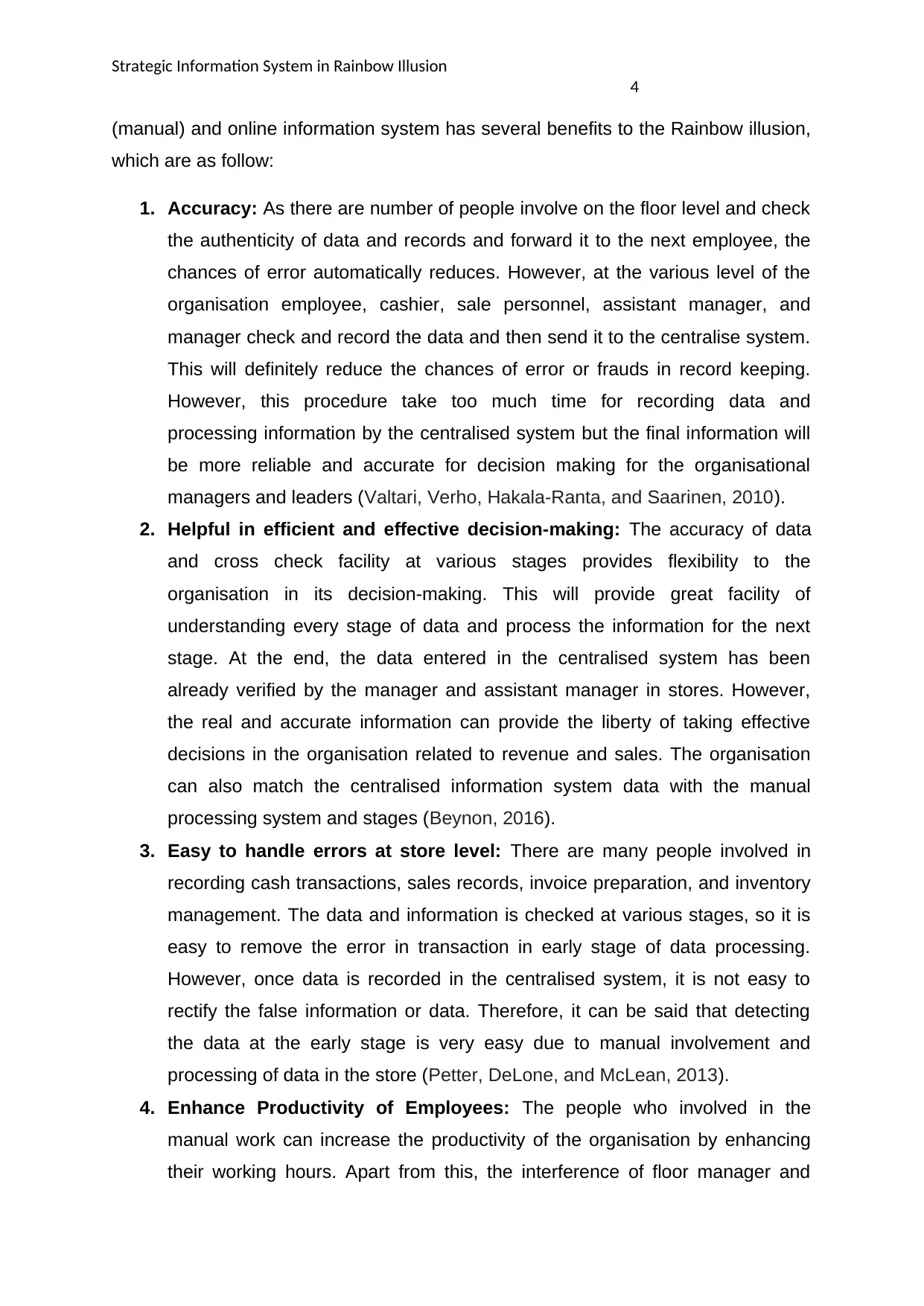
Strategic Information System in Rainbow Illusion
4
(manual) and online information system has several benefits to the Rainbow illusion,
which are as follow:
1. Accuracy: As there are number of people involve on the floor level and check
the authenticity of data and records and forward it to the next employee, the
chances of error automatically reduces. However, at the various level of the
organisation employee, cashier, sale personnel, assistant manager, and
manager check and record the data and then send it to the centralise system.
This will definitely reduce the chances of error or frauds in record keeping.
However, this procedure take too much time for recording data and
processing information by the centralised system but the final information will
be more reliable and accurate for decision making for the organisational
managers and leaders (Valtari, Verho, Hakala-Ranta, and Saarinen, 2010).
2. Helpful in efficient and effective decision-making: The accuracy of data
and cross check facility at various stages provides flexibility to the
organisation in its decision-making. This will provide great facility of
understanding every stage of data and process the information for the next
stage. At the end, the data entered in the centralised system has been
already verified by the manager and assistant manager in stores. However,
the real and accurate information can provide the liberty of taking effective
decisions in the organisation related to revenue and sales. The organisation
can also match the centralised information system data with the manual
processing system and stages (Beynon, 2016).
3. Easy to handle errors at store level: There are many people involved in
recording cash transactions, sales records, invoice preparation, and inventory
management. The data and information is checked at various stages, so it is
easy to remove the error in transaction in early stage of data processing.
However, once data is recorded in the centralised system, it is not easy to
rectify the false information or data. Therefore, it can be said that detecting
the data at the early stage is very easy due to manual involvement and
processing of data in the store (Petter, DeLone, and McLean, 2013).
4. Enhance Productivity of Employees: The people who involved in the
manual work can increase the productivity of the organisation by enhancing
their working hours. Apart from this, the interference of floor manager and
4
(manual) and online information system has several benefits to the Rainbow illusion,
which are as follow:
1. Accuracy: As there are number of people involve on the floor level and check
the authenticity of data and records and forward it to the next employee, the
chances of error automatically reduces. However, at the various level of the
organisation employee, cashier, sale personnel, assistant manager, and
manager check and record the data and then send it to the centralise system.
This will definitely reduce the chances of error or frauds in record keeping.
However, this procedure take too much time for recording data and
processing information by the centralised system but the final information will
be more reliable and accurate for decision making for the organisational
managers and leaders (Valtari, Verho, Hakala-Ranta, and Saarinen, 2010).
2. Helpful in efficient and effective decision-making: The accuracy of data
and cross check facility at various stages provides flexibility to the
organisation in its decision-making. This will provide great facility of
understanding every stage of data and process the information for the next
stage. At the end, the data entered in the centralised system has been
already verified by the manager and assistant manager in stores. However,
the real and accurate information can provide the liberty of taking effective
decisions in the organisation related to revenue and sales. The organisation
can also match the centralised information system data with the manual
processing system and stages (Beynon, 2016).
3. Easy to handle errors at store level: There are many people involved in
recording cash transactions, sales records, invoice preparation, and inventory
management. The data and information is checked at various stages, so it is
easy to remove the error in transaction in early stage of data processing.
However, once data is recorded in the centralised system, it is not easy to
rectify the false information or data. Therefore, it can be said that detecting
the data at the early stage is very easy due to manual involvement and
processing of data in the store (Petter, DeLone, and McLean, 2013).
4. Enhance Productivity of Employees: The people who involved in the
manual work can increase the productivity of the organisation by enhancing
their working hours. Apart from this, the interference of floor manager and
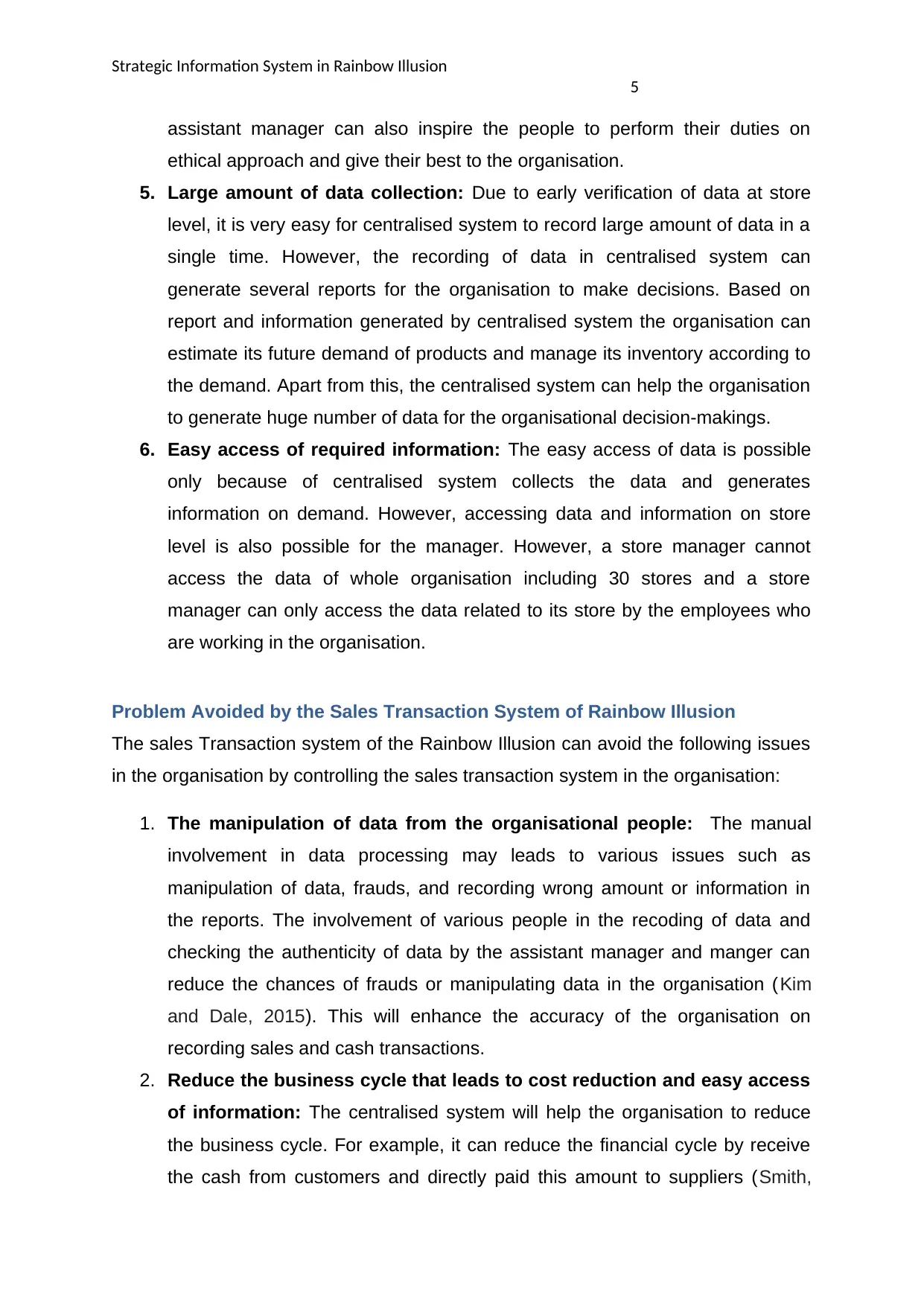
Strategic Information System in Rainbow Illusion
5
assistant manager can also inspire the people to perform their duties on
ethical approach and give their best to the organisation.
5. Large amount of data collection: Due to early verification of data at store
level, it is very easy for centralised system to record large amount of data in a
single time. However, the recording of data in centralised system can
generate several reports for the organisation to make decisions. Based on
report and information generated by centralised system the organisation can
estimate its future demand of products and manage its inventory according to
the demand. Apart from this, the centralised system can help the organisation
to generate huge number of data for the organisational decision-makings.
6. Easy access of required information: The easy access of data is possible
only because of centralised system collects the data and generates
information on demand. However, accessing data and information on store
level is also possible for the manager. However, a store manager cannot
access the data of whole organisation including 30 stores and a store
manager can only access the data related to its store by the employees who
are working in the organisation.
Problem Avoided by the Sales Transaction System of Rainbow Illusion
The sales Transaction system of the Rainbow Illusion can avoid the following issues
in the organisation by controlling the sales transaction system in the organisation:
1. The manipulation of data from the organisational people: The manual
involvement in data processing may leads to various issues such as
manipulation of data, frauds, and recording wrong amount or information in
the reports. The involvement of various people in the recoding of data and
checking the authenticity of data by the assistant manager and manger can
reduce the chances of frauds or manipulating data in the organisation (Kim
and Dale, 2015). This will enhance the accuracy of the organisation on
recording sales and cash transactions.
2. Reduce the business cycle that leads to cost reduction and easy access
of information: The centralised system will help the organisation to reduce
the business cycle. For example, it can reduce the financial cycle by receive
the cash from customers and directly paid this amount to suppliers (Smith,
5
assistant manager can also inspire the people to perform their duties on
ethical approach and give their best to the organisation.
5. Large amount of data collection: Due to early verification of data at store
level, it is very easy for centralised system to record large amount of data in a
single time. However, the recording of data in centralised system can
generate several reports for the organisation to make decisions. Based on
report and information generated by centralised system the organisation can
estimate its future demand of products and manage its inventory according to
the demand. Apart from this, the centralised system can help the organisation
to generate huge number of data for the organisational decision-makings.
6. Easy access of required information: The easy access of data is possible
only because of centralised system collects the data and generates
information on demand. However, accessing data and information on store
level is also possible for the manager. However, a store manager cannot
access the data of whole organisation including 30 stores and a store
manager can only access the data related to its store by the employees who
are working in the organisation.
Problem Avoided by the Sales Transaction System of Rainbow Illusion
The sales Transaction system of the Rainbow Illusion can avoid the following issues
in the organisation by controlling the sales transaction system in the organisation:
1. The manipulation of data from the organisational people: The manual
involvement in data processing may leads to various issues such as
manipulation of data, frauds, and recording wrong amount or information in
the reports. The involvement of various people in the recoding of data and
checking the authenticity of data by the assistant manager and manger can
reduce the chances of frauds or manipulating data in the organisation (Kim
and Dale, 2015). This will enhance the accuracy of the organisation on
recording sales and cash transactions.
2. Reduce the business cycle that leads to cost reduction and easy access
of information: The centralised system will help the organisation to reduce
the business cycle. For example, it can reduce the financial cycle by receive
the cash from customers and directly paid this amount to suppliers (Smith,
⊘ This is a preview!⊘
Do you want full access?
Subscribe today to unlock all pages.

Trusted by 1+ million students worldwide
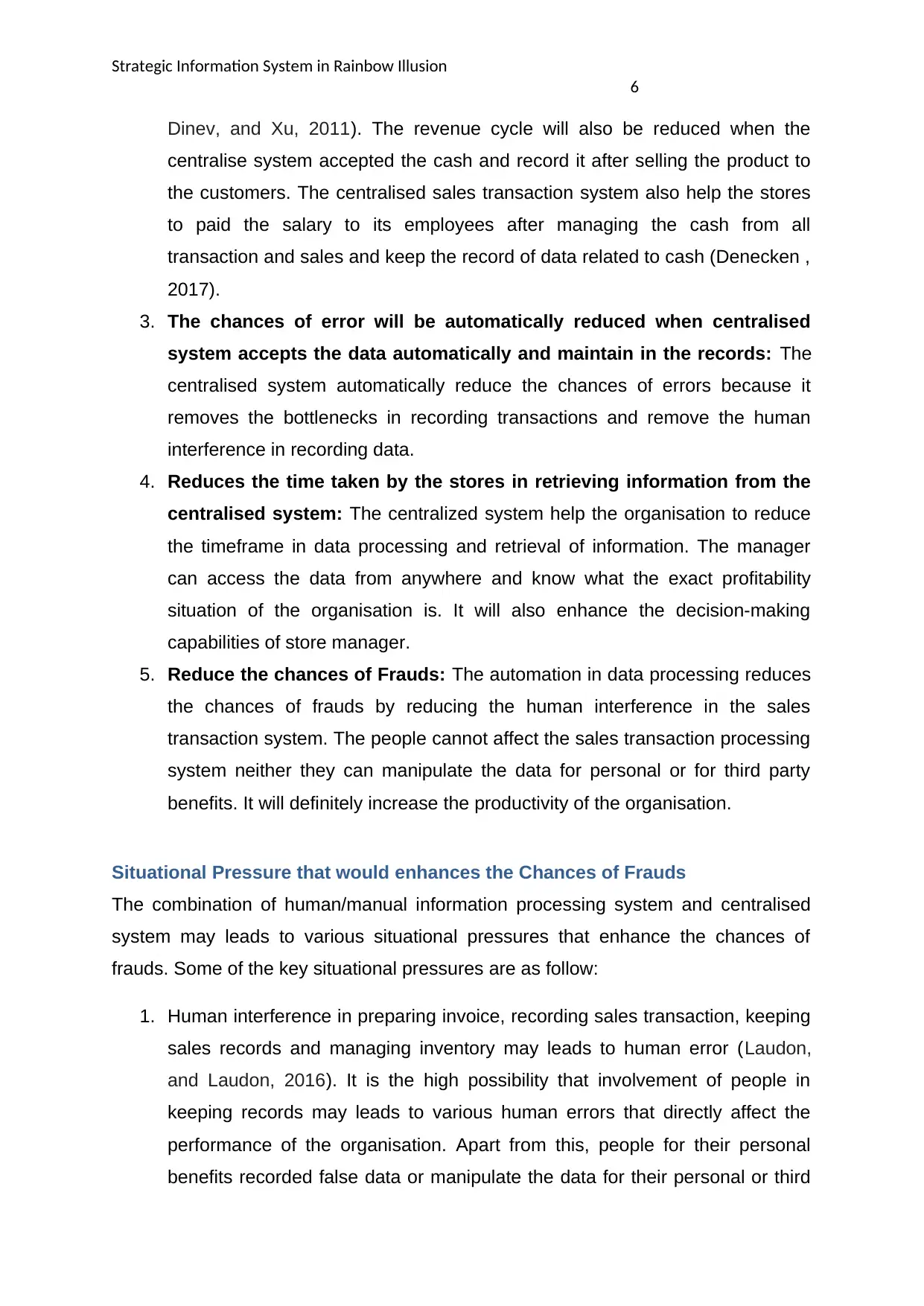
Strategic Information System in Rainbow Illusion
6
Dinev, and Xu, 2011). The revenue cycle will also be reduced when the
centralise system accepted the cash and record it after selling the product to
the customers. The centralised sales transaction system also help the stores
to paid the salary to its employees after managing the cash from all
transaction and sales and keep the record of data related to cash (Denecken ,
2017).
3. The chances of error will be automatically reduced when centralised
system accepts the data automatically and maintain in the records: The
centralised system automatically reduce the chances of errors because it
removes the bottlenecks in recording transactions and remove the human
interference in recording data.
4. Reduces the time taken by the stores in retrieving information from the
centralised system: The centralized system help the organisation to reduce
the timeframe in data processing and retrieval of information. The manager
can access the data from anywhere and know what the exact profitability
situation of the organisation is. It will also enhance the decision-making
capabilities of store manager.
5. Reduce the chances of Frauds: The automation in data processing reduces
the chances of frauds by reducing the human interference in the sales
transaction system. The people cannot affect the sales transaction processing
system neither they can manipulate the data for personal or for third party
benefits. It will definitely increase the productivity of the organisation.
Situational Pressure that would enhances the Chances of Frauds
The combination of human/manual information processing system and centralised
system may leads to various situational pressures that enhance the chances of
frauds. Some of the key situational pressures are as follow:
1. Human interference in preparing invoice, recording sales transaction, keeping
sales records and managing inventory may leads to human error (Laudon,
and Laudon, 2016). It is the high possibility that involvement of people in
keeping records may leads to various human errors that directly affect the
performance of the organisation. Apart from this, people for their personal
benefits recorded false data or manipulate the data for their personal or third
6
Dinev, and Xu, 2011). The revenue cycle will also be reduced when the
centralise system accepted the cash and record it after selling the product to
the customers. The centralised sales transaction system also help the stores
to paid the salary to its employees after managing the cash from all
transaction and sales and keep the record of data related to cash (Denecken ,
2017).
3. The chances of error will be automatically reduced when centralised
system accepts the data automatically and maintain in the records: The
centralised system automatically reduce the chances of errors because it
removes the bottlenecks in recording transactions and remove the human
interference in recording data.
4. Reduces the time taken by the stores in retrieving information from the
centralised system: The centralized system help the organisation to reduce
the timeframe in data processing and retrieval of information. The manager
can access the data from anywhere and know what the exact profitability
situation of the organisation is. It will also enhance the decision-making
capabilities of store manager.
5. Reduce the chances of Frauds: The automation in data processing reduces
the chances of frauds by reducing the human interference in the sales
transaction system. The people cannot affect the sales transaction processing
system neither they can manipulate the data for personal or for third party
benefits. It will definitely increase the productivity of the organisation.
Situational Pressure that would enhances the Chances of Frauds
The combination of human/manual information processing system and centralised
system may leads to various situational pressures that enhance the chances of
frauds. Some of the key situational pressures are as follow:
1. Human interference in preparing invoice, recording sales transaction, keeping
sales records and managing inventory may leads to human error (Laudon,
and Laudon, 2016). It is the high possibility that involvement of people in
keeping records may leads to various human errors that directly affect the
performance of the organisation. Apart from this, people for their personal
benefits recorded false data or manipulate the data for their personal or third
Paraphrase This Document
Need a fresh take? Get an instant paraphrase of this document with our AI Paraphraser
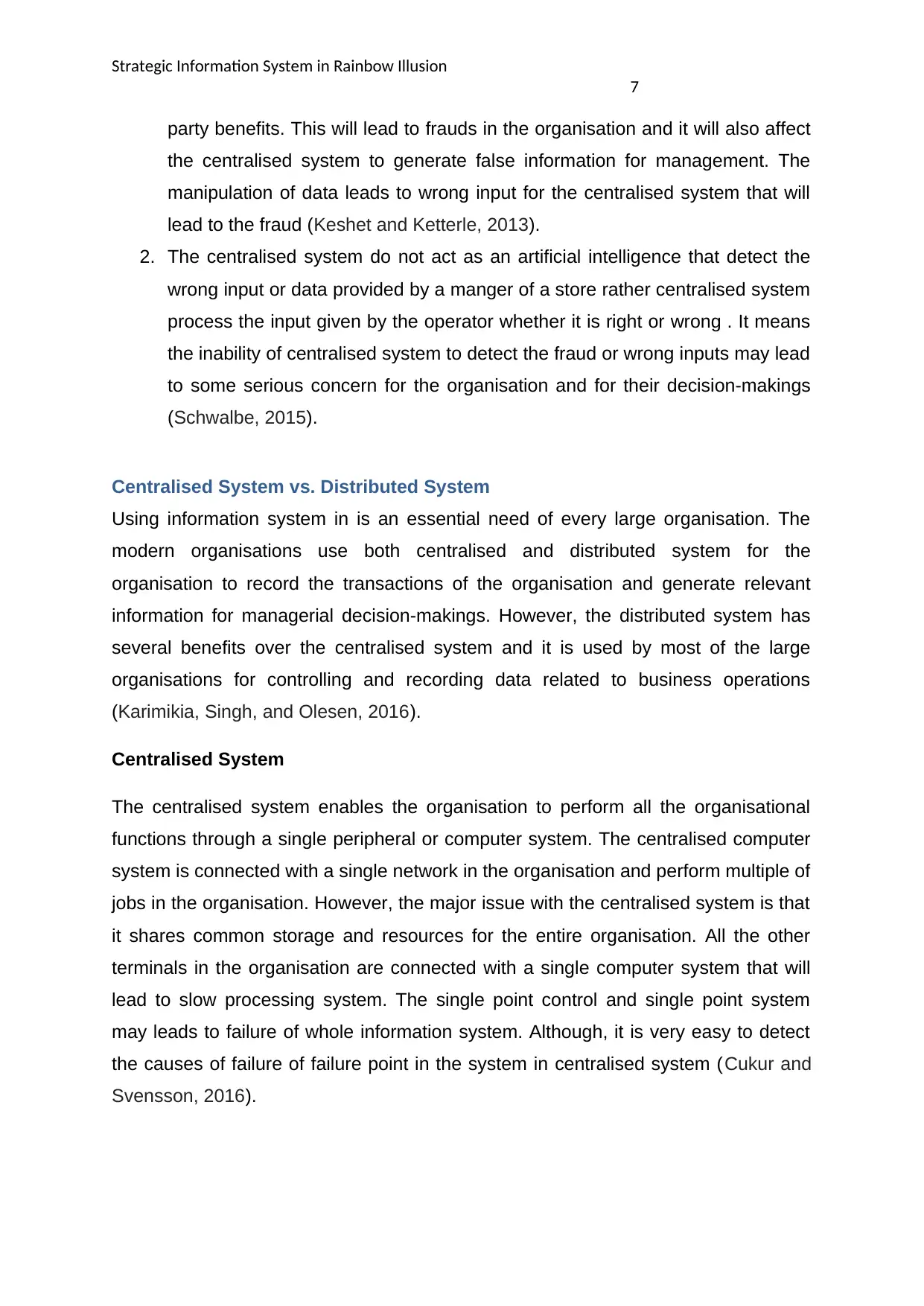
Strategic Information System in Rainbow Illusion
7
party benefits. This will lead to frauds in the organisation and it will also affect
the centralised system to generate false information for management. The
manipulation of data leads to wrong input for the centralised system that will
lead to the fraud (Keshet and Ketterle, 2013).
2. The centralised system do not act as an artificial intelligence that detect the
wrong input or data provided by a manger of a store rather centralised system
process the input given by the operator whether it is right or wrong . It means
the inability of centralised system to detect the fraud or wrong inputs may lead
to some serious concern for the organisation and for their decision-makings
(Schwalbe, 2015).
Centralised System vs. Distributed System
Using information system in is an essential need of every large organisation. The
modern organisations use both centralised and distributed system for the
organisation to record the transactions of the organisation and generate relevant
information for managerial decision-makings. However, the distributed system has
several benefits over the centralised system and it is used by most of the large
organisations for controlling and recording data related to business operations
(Karimikia, Singh, and Olesen, 2016).
Centralised System
The centralised system enables the organisation to perform all the organisational
functions through a single peripheral or computer system. The centralised computer
system is connected with a single network in the organisation and perform multiple of
jobs in the organisation. However, the major issue with the centralised system is that
it shares common storage and resources for the entire organisation. All the other
terminals in the organisation are connected with a single computer system that will
lead to slow processing system. The single point control and single point system
may leads to failure of whole information system. Although, it is very easy to detect
the causes of failure of failure point in the system in centralised system (Cukur and
Svensson, 2016).
7
party benefits. This will lead to frauds in the organisation and it will also affect
the centralised system to generate false information for management. The
manipulation of data leads to wrong input for the centralised system that will
lead to the fraud (Keshet and Ketterle, 2013).
2. The centralised system do not act as an artificial intelligence that detect the
wrong input or data provided by a manger of a store rather centralised system
process the input given by the operator whether it is right or wrong . It means
the inability of centralised system to detect the fraud or wrong inputs may lead
to some serious concern for the organisation and for their decision-makings
(Schwalbe, 2015).
Centralised System vs. Distributed System
Using information system in is an essential need of every large organisation. The
modern organisations use both centralised and distributed system for the
organisation to record the transactions of the organisation and generate relevant
information for managerial decision-makings. However, the distributed system has
several benefits over the centralised system and it is used by most of the large
organisations for controlling and recording data related to business operations
(Karimikia, Singh, and Olesen, 2016).
Centralised System
The centralised system enables the organisation to perform all the organisational
functions through a single peripheral or computer system. The centralised computer
system is connected with a single network in the organisation and perform multiple of
jobs in the organisation. However, the major issue with the centralised system is that
it shares common storage and resources for the entire organisation. All the other
terminals in the organisation are connected with a single computer system that will
lead to slow processing system. The single point control and single point system
may leads to failure of whole information system. Although, it is very easy to detect
the causes of failure of failure point in the system in centralised system (Cukur and
Svensson, 2016).
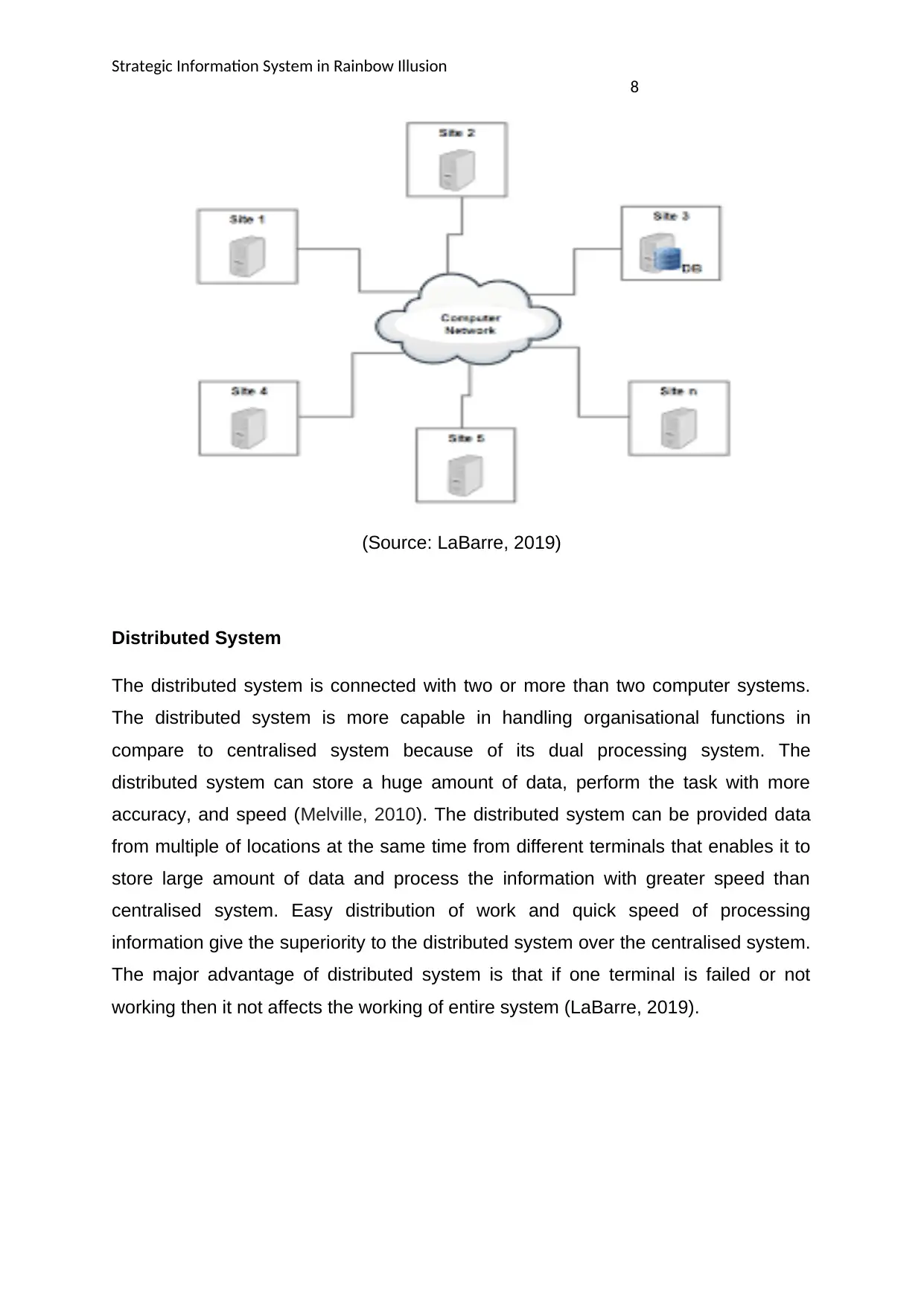
Strategic Information System in Rainbow Illusion
8
(Source: LaBarre, 2019)
Distributed System
The distributed system is connected with two or more than two computer systems.
The distributed system is more capable in handling organisational functions in
compare to centralised system because of its dual processing system. The
distributed system can store a huge amount of data, perform the task with more
accuracy, and speed (Melville, 2010). The distributed system can be provided data
from multiple of locations at the same time from different terminals that enables it to
store large amount of data and process the information with greater speed than
centralised system. Easy distribution of work and quick speed of processing
information give the superiority to the distributed system over the centralised system.
The major advantage of distributed system is that if one terminal is failed or not
working then it not affects the working of entire system (LaBarre, 2019).
8
(Source: LaBarre, 2019)
Distributed System
The distributed system is connected with two or more than two computer systems.
The distributed system is more capable in handling organisational functions in
compare to centralised system because of its dual processing system. The
distributed system can store a huge amount of data, perform the task with more
accuracy, and speed (Melville, 2010). The distributed system can be provided data
from multiple of locations at the same time from different terminals that enables it to
store large amount of data and process the information with greater speed than
centralised system. Easy distribution of work and quick speed of processing
information give the superiority to the distributed system over the centralised system.
The major advantage of distributed system is that if one terminal is failed or not
working then it not affects the working of entire system (LaBarre, 2019).
⊘ This is a preview!⊘
Do you want full access?
Subscribe today to unlock all pages.

Trusted by 1+ million students worldwide
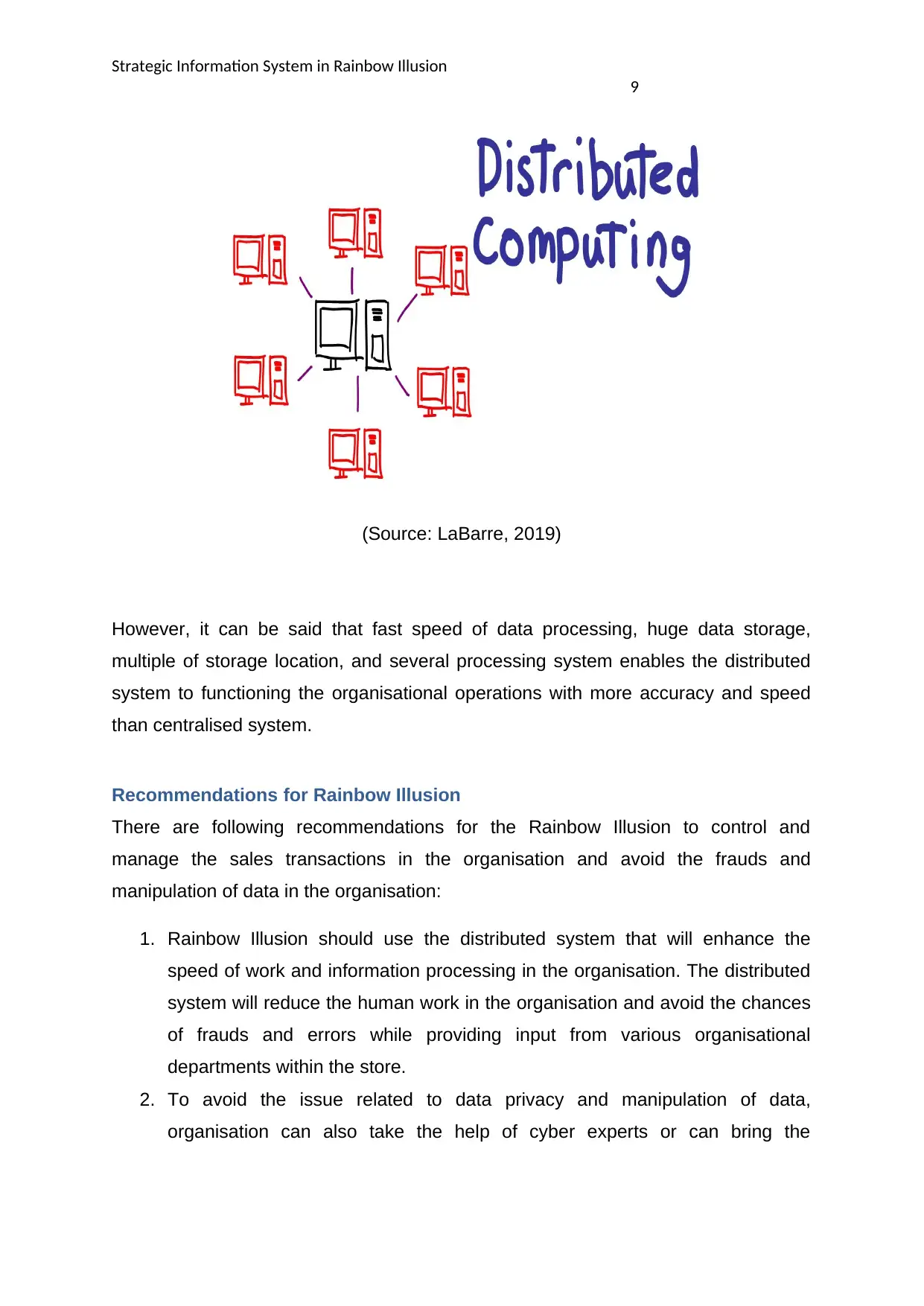
Strategic Information System in Rainbow Illusion
9
(Source: LaBarre, 2019)
However, it can be said that fast speed of data processing, huge data storage,
multiple of storage location, and several processing system enables the distributed
system to functioning the organisational operations with more accuracy and speed
than centralised system.
Recommendations for Rainbow Illusion
There are following recommendations for the Rainbow Illusion to control and
manage the sales transactions in the organisation and avoid the frauds and
manipulation of data in the organisation:
1. Rainbow Illusion should use the distributed system that will enhance the
speed of work and information processing in the organisation. The distributed
system will reduce the human work in the organisation and avoid the chances
of frauds and errors while providing input from various organisational
departments within the store.
2. To avoid the issue related to data privacy and manipulation of data,
organisation can also take the help of cyber experts or can bring the
9
(Source: LaBarre, 2019)
However, it can be said that fast speed of data processing, huge data storage,
multiple of storage location, and several processing system enables the distributed
system to functioning the organisational operations with more accuracy and speed
than centralised system.
Recommendations for Rainbow Illusion
There are following recommendations for the Rainbow Illusion to control and
manage the sales transactions in the organisation and avoid the frauds and
manipulation of data in the organisation:
1. Rainbow Illusion should use the distributed system that will enhance the
speed of work and information processing in the organisation. The distributed
system will reduce the human work in the organisation and avoid the chances
of frauds and errors while providing input from various organisational
departments within the store.
2. To avoid the issue related to data privacy and manipulation of data,
organisation can also take the help of cyber experts or can bring the
Paraphrase This Document
Need a fresh take? Get an instant paraphrase of this document with our AI Paraphraser
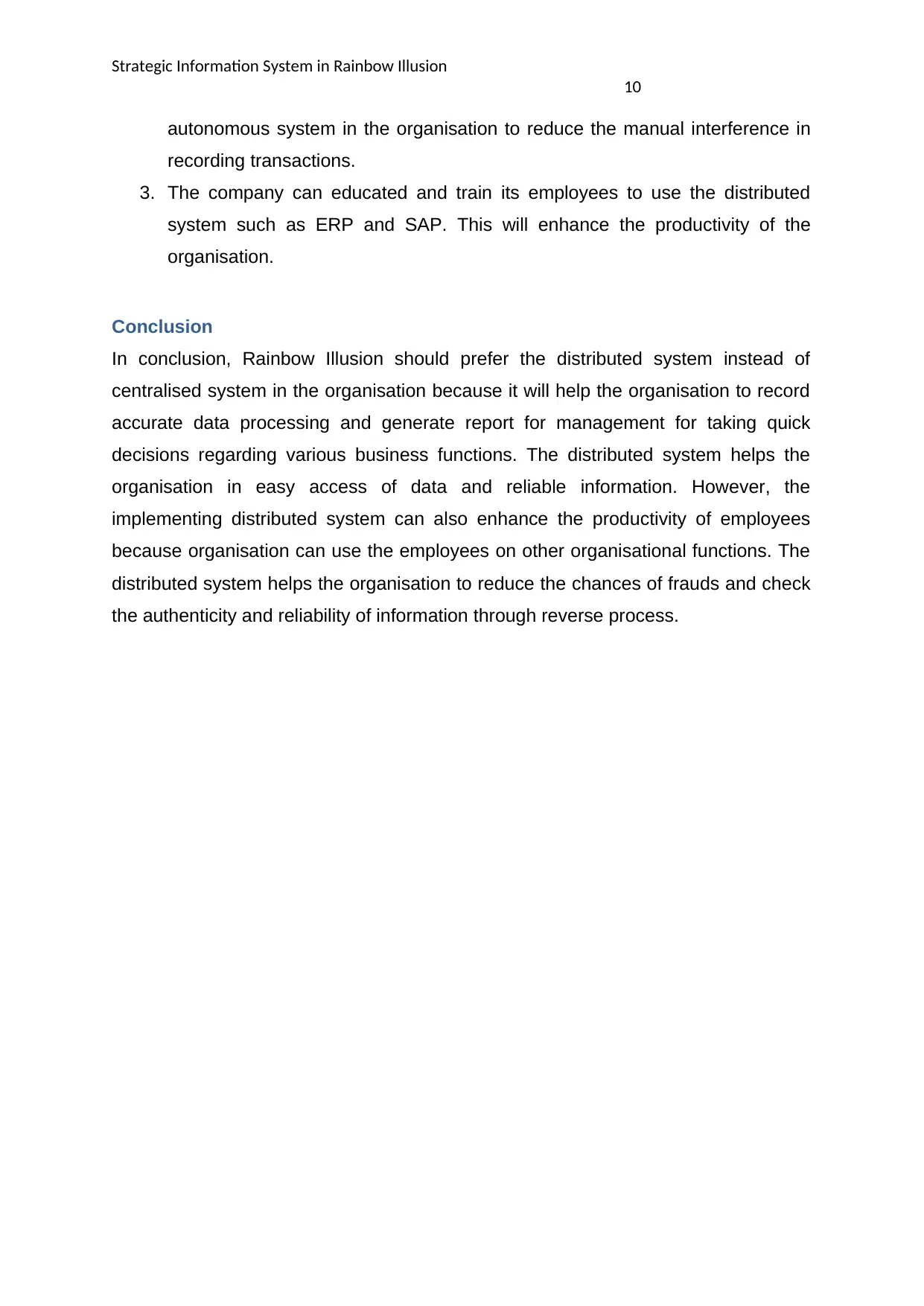
Strategic Information System in Rainbow Illusion
10
autonomous system in the organisation to reduce the manual interference in
recording transactions.
3. The company can educated and train its employees to use the distributed
system such as ERP and SAP. This will enhance the productivity of the
organisation.
Conclusion
In conclusion, Rainbow Illusion should prefer the distributed system instead of
centralised system in the organisation because it will help the organisation to record
accurate data processing and generate report for management for taking quick
decisions regarding various business functions. The distributed system helps the
organisation in easy access of data and reliable information. However, the
implementing distributed system can also enhance the productivity of employees
because organisation can use the employees on other organisational functions. The
distributed system helps the organisation to reduce the chances of frauds and check
the authenticity and reliability of information through reverse process.
10
autonomous system in the organisation to reduce the manual interference in
recording transactions.
3. The company can educated and train its employees to use the distributed
system such as ERP and SAP. This will enhance the productivity of the
organisation.
Conclusion
In conclusion, Rainbow Illusion should prefer the distributed system instead of
centralised system in the organisation because it will help the organisation to record
accurate data processing and generate report for management for taking quick
decisions regarding various business functions. The distributed system helps the
organisation in easy access of data and reliable information. However, the
implementing distributed system can also enhance the productivity of employees
because organisation can use the employees on other organisational functions. The
distributed system helps the organisation to reduce the chances of frauds and check
the authenticity and reliability of information through reverse process.
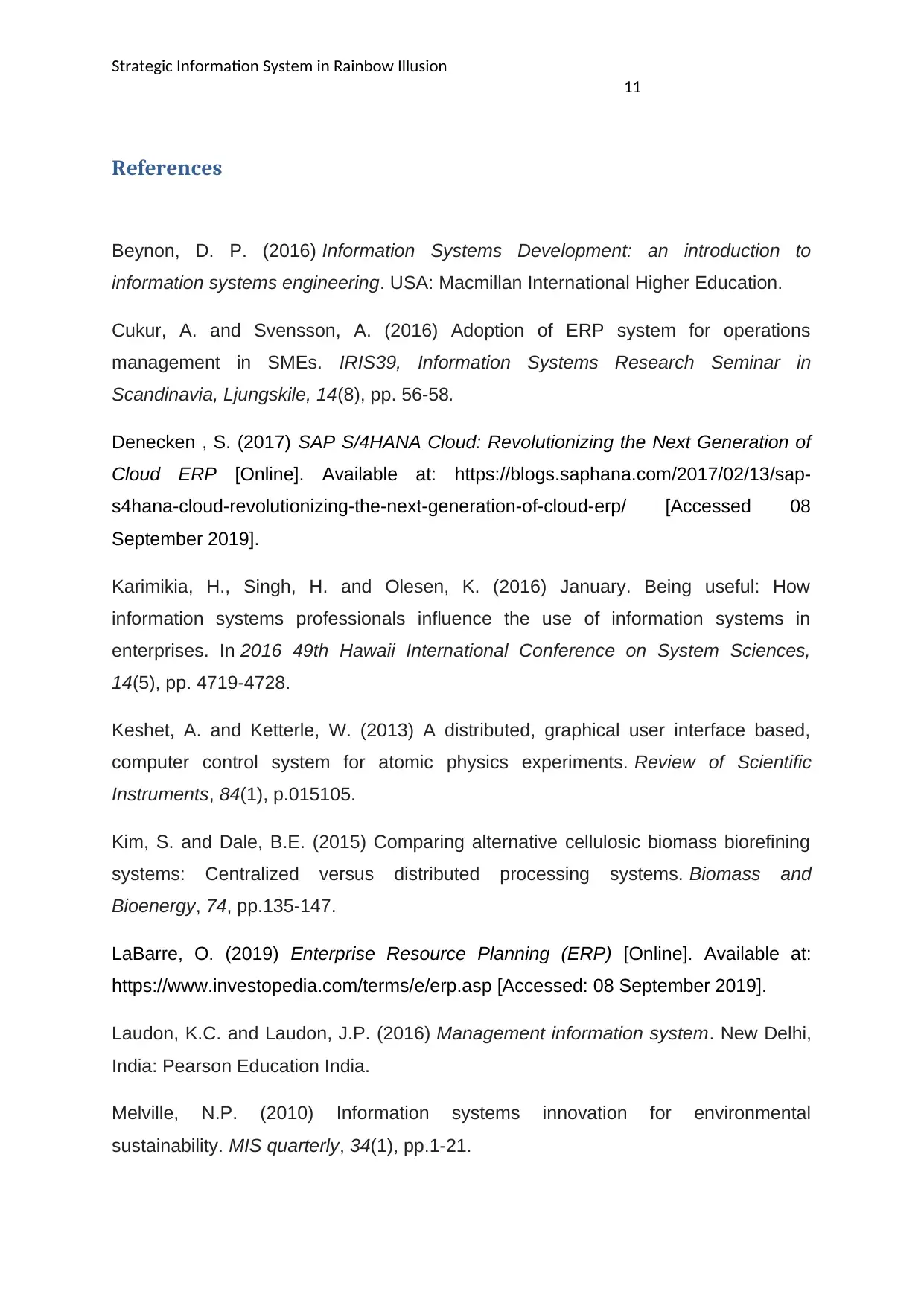
Strategic Information System in Rainbow Illusion
11
References
Beynon, D. P. (2016) Information Systems Development: an introduction to
information systems engineering. USA: Macmillan International Higher Education.
Cukur, A. and Svensson, A. (2016) Adoption of ERP system for operations
management in SMEs. IRIS39, Information Systems Research Seminar in
Scandinavia, Ljungskile, 14(8), pp. 56-58.
Denecken , S. (2017) SAP S/4HANA Cloud: Revolutionizing the Next Generation of
Cloud ERP [Online]. Available at: https://blogs.saphana.com/2017/02/13/sap-
s4hana-cloud-revolutionizing-the-next-generation-of-cloud-erp/ [Accessed 08
September 2019].
Karimikia, H., Singh, H. and Olesen, K. (2016) January. Being useful: How
information systems professionals influence the use of information systems in
enterprises. In 2016 49th Hawaii International Conference on System Sciences,
14(5), pp. 4719-4728.
Keshet, A. and Ketterle, W. (2013) A distributed, graphical user interface based,
computer control system for atomic physics experiments. Review of Scientific
Instruments, 84(1), p.015105.
Kim, S. and Dale, B.E. (2015) Comparing alternative cellulosic biomass biorefining
systems: Centralized versus distributed processing systems. Biomass and
Bioenergy, 74, pp.135-147.
LaBarre, O. (2019) Enterprise Resource Planning (ERP) [Online]. Available at:
https://www.investopedia.com/terms/e/erp.asp [Accessed: 08 September 2019].
Laudon, K.C. and Laudon, J.P. (2016) Management information system. New Delhi,
India: Pearson Education India.
Melville, N.P. (2010) Information systems innovation for environmental
sustainability. MIS quarterly, 34(1), pp.1-21.
11
References
Beynon, D. P. (2016) Information Systems Development: an introduction to
information systems engineering. USA: Macmillan International Higher Education.
Cukur, A. and Svensson, A. (2016) Adoption of ERP system for operations
management in SMEs. IRIS39, Information Systems Research Seminar in
Scandinavia, Ljungskile, 14(8), pp. 56-58.
Denecken , S. (2017) SAP S/4HANA Cloud: Revolutionizing the Next Generation of
Cloud ERP [Online]. Available at: https://blogs.saphana.com/2017/02/13/sap-
s4hana-cloud-revolutionizing-the-next-generation-of-cloud-erp/ [Accessed 08
September 2019].
Karimikia, H., Singh, H. and Olesen, K. (2016) January. Being useful: How
information systems professionals influence the use of information systems in
enterprises. In 2016 49th Hawaii International Conference on System Sciences,
14(5), pp. 4719-4728.
Keshet, A. and Ketterle, W. (2013) A distributed, graphical user interface based,
computer control system for atomic physics experiments. Review of Scientific
Instruments, 84(1), p.015105.
Kim, S. and Dale, B.E. (2015) Comparing alternative cellulosic biomass biorefining
systems: Centralized versus distributed processing systems. Biomass and
Bioenergy, 74, pp.135-147.
LaBarre, O. (2019) Enterprise Resource Planning (ERP) [Online]. Available at:
https://www.investopedia.com/terms/e/erp.asp [Accessed: 08 September 2019].
Laudon, K.C. and Laudon, J.P. (2016) Management information system. New Delhi,
India: Pearson Education India.
Melville, N.P. (2010) Information systems innovation for environmental
sustainability. MIS quarterly, 34(1), pp.1-21.
⊘ This is a preview!⊘
Do you want full access?
Subscribe today to unlock all pages.

Trusted by 1+ million students worldwide
1 out of 13
Related Documents
Your All-in-One AI-Powered Toolkit for Academic Success.
+13062052269
info@desklib.com
Available 24*7 on WhatsApp / Email
![[object Object]](/_next/static/media/star-bottom.7253800d.svg)
Unlock your academic potential
Copyright © 2020–2025 A2Z Services. All Rights Reserved. Developed and managed by ZUCOL.





